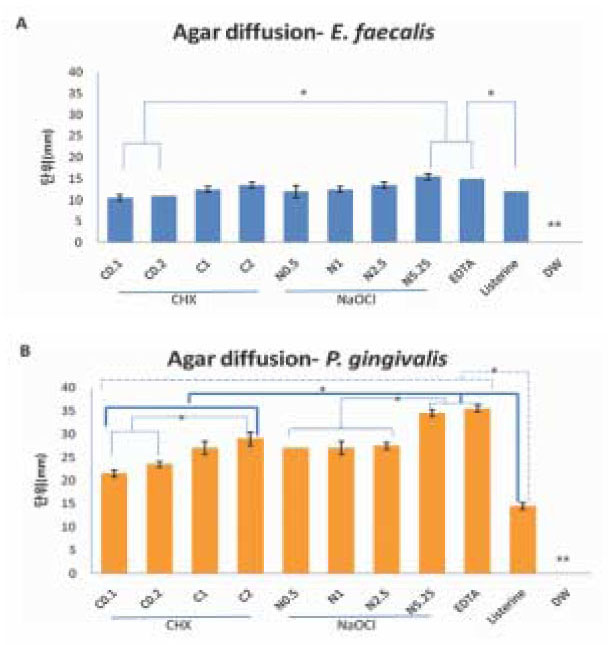J Korean Acad Conserv Dent.
2009 Nov;34(6):500-507. 10.5395/JKACD.2009.34.6.500.
Comparison of Antibacterial effect of Listerine(R) with Various root canal irrigants
- Affiliations
-
- 1Department of Conservative Dentistry, School of Dentistry, Chonnam National University, Korea. wmoh@chonnam.ac.kr
- 2Department of Oral Microbiology, School of Dentistry, Chonnam National University, Korea.
- 3Department of Oral Anatomy, School of Dentistry, Chonnam National University, Korea.
- 4DSRI, Chonnam National University, Korea.
- 52nd stage of BK21, Chonnam National University, Korea.
- 6Department of Conservative Dentistry, School of Dentistry, Seoul National University, Korea.
- KMID: 1986613
- DOI: http://doi.org/10.5395/JKACD.2009.34.6.500
Abstract
- The purpose of this study is to compare the antibacterial effect of Listerine(R) on two microorganisms (P. gingivalis and E. faecalis) with various root canal irrigants (NaOCl, CHX, EDTA) and to identify possibility of using Listerine(R) as a root canal irrigant. Porphyromonas gingivalis ATCC 3327 and Enterococcus faecalis ATCC 29212 were used in this experiment. For the test irrigants, 0.5%, 1%, 2.5%, 5.25% NaOCl, 0.1%, 0.2%, 1%, 2% CHX, 0.5M EDTA (18.6% EDTA) and Listerine(R) were prepared. Distiled water was used as control. Two methods-1) Comparison of turbidity in broth and 2) Agar diffusion test-were used to determine the extent of antibacterial effect of Listerine(R) and to compare it with that of NaOCl, CHX, and EDTA. All solutions tested were effective against two bacterial strains compared with control (p<0.001). Any concentration of NaOCl, CHX, and EDTA showed similarly high effectiveness against all bacterial strains. In all experiment, Listerine(R) showed significantly low antibacterial effect compared with the other root canal irrigants (p<0.05). In conclusion, the results reflect remarkably low antibacterial effect of Listerine(R) as compared with root canal irrigants in general so it is not suitable for the root canal irrigant.
MeSH Terms
Figure
Reference
-
1. Gentil M, Pereira JV, Sousa YT, Pietro R, Neto MD, Vansan LP, de Castro França S. In vitro evaluation of the antibacterial activity of Arctium lappa as a phytotherapeutic agent used in intracanal dressings. Phytother Res. 2006. 20:184–186.
Article2. Carson KR, Goodell GG, McClanahan SB. Comparison of the antimicrobial activity of six irrigants on primary endodontic pathogens. J Endod. 2005. 31:471–473.
Article3. Murray PE, Farber RM, Namerow KN, Kuttler S, Garcia-Godoy F. Evaluation of Morinda citrfolia as an Endodontic Irrigant. J Endod. 2008. 34:66–70.4. Kim HJ, Park SH, Cho KM, Kim JW. Evaluation of time-dependent antimicrobial effect of sodium dichloroisocyanurate (NaDCC) on Enterococcus faecalis in the root canal. J Korean Acad Conserv Dent. 2007. 32:121–129.
Article5. Zehnder M. Root canal irrigants. J Endod. 2006. 32:389–398.
Article6. Seymour R. Additional properties and Used of essential oils. J Clin Periodontol. 2003. 30:suppl.5. 19–21.7. Torabinejad M, Shabahang S, Aprecio RM, Kettering JD. The antimicrobial effect of MTAD: an in vitro investigation. J Endod. 2003. 29:400–403.
Article8. Siqueira JF Jr, Batista MM, Fraga RC, de Uzeda M. Antibacterial effects of endodontic irrigants on black-pigmented Gram-negative anaerobes and facultative bacteria. J Endod. 1998. 24:414–416.
Article9. Sundqvist G, Figdor D, Persson S, Sjögren U. Microbiologic analysis of teeth with failed endodontic treatment and the outcome of conservative retreatment. Oral Surg Oral Med Oral Pathol Oral Radiol Endod. 1998. 85:86–93.
Article10. Shin JH, Park SJ, Choi KW. Antibacterial Effect of Polyphosphate on Endodontopathic Bacteria. J Korean Acad Conserv Dent. 2003. 28:435–448.
Article11. Dakin HD. On the use of certain antiseptic substances in treatment of infected wounds. Br Med J. 1915. 2:318–320.
Article12. Bystrom A, Sundqvist G. Bacteriological evaluation of the effect of 0.5% sodium hypochlorite in endodontic therapy. Oral Surg Oral Med Oral Pathol. 1983. 55:307–312.13. D'Arcangelo C, Varvara G, De Fazio P. An evaluation of the action of different root canal irrigants on facultative aerobic-anaerobic, obligate anaerobic, and microaerophilic bacteria. J Endod. 1999. 25:351–353.14. Shin JS, Cho YB. Removal Patterns of Smear Layer According to Application Temperature and Time of EDTA. J Korean Acad Conserv Dent. 2002. 27:535–542.
Article15. Zehnder M, Schmidlin P, Sener B, Waltimo T. Chelation in root canal therapy reconsidered. J Endod. 2005. 31:817–820.
Article16. Masillamoni CR, Kettering JD, Torabinejad M. The biocompatibility of some root canal medicaments and irrigants. Int Endod J. 1981. 14:115–120.
Article17. Georgopoulou M, Kontakiotis E, Nakou M. Evaluation of the antimicrobial effectiveness of citric acid and sodium hypochlorite on the anaerobic flora of the infected root canal. Int Endod J. 1994. 27:139–143.
Article18. Takarada K, Kimizuka R, Takahashi N, Honma K, Okuda K, Kato T. A comparison of the antibacterial efficacies of essential oils against oral pathogens. Oral Microbiol Immunol. 2004. 19:61–64.
Article
- Full Text Links
- Actions
-
Cited
- CITED
-
- Close
- Share
- Similar articles
-
- Antibacterial effect of urushiol on E. faecalis as a root canal irrigant
- Evaluation of time-dependent antimicrobial effect of sodium dichloroisocyanurate (NaDCC) on Enterococcus faecalis in the root canal
- Clinical efficacy of activated irrigation in endodontics: a focused review
- Comparison of various activation methods of root canal irrigants for soft-tissue removal
- Root canal irrigants influence the hydrophobicity and adherence of Staphylococcus epidermidis to root canal dentin: an in vitro study



